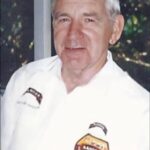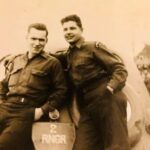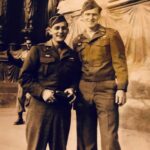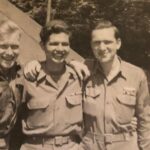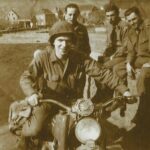Ranger Joseph Drake
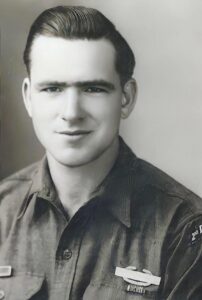
SGT Joseph Drake
Born: 24 October 1924
Army Serial Number: 33604644
Ranger Battalion/Company: 2/A
Rank: SGT
Enlisted: 30 April 1943
Battles/Campaigns/Significants: Normandy, Northern France, Ardennes-Alsace, Central Europe, Rhineland
Medals/Awards: CIB, BSM, Good Conduct Medal, European Campaign Medal, WWII Victory Medal, American Campaign Medal, Presidential Unit Citation
Biography
Joseph Drake was born on 24 October 1924.
Drafted 30 April 1943, Joe was inducted into the Army at New Cumberland Army Reception Center, PA, on 9 May 1943 and sent to Camp Shelby, MS, for 13 weeks of basic training. He was among 15,000 men in the 69th Division. This was followed by many additional months of advanced infantry training at various posts in Mississippi and Louisiana. He was also trained to be a supply technician and issued the MOS 821. As he awaited his journey to Europe, he was delayed due to heavy enemy submarine activity in the Atlantic. Subsequently his stay was prolonged until he finally was brought to New York City where he spent “a couple of days” on a ship in the harbor. One morning he awoke and found himself surrounded by an endless horizon. In June 1944 he was sent to England as an individual infantry replacement. Arriving in the UK on D+9, 15 June 1944 he, along with a buddy Willie Day who he had been training with, volunteered for the Rangers "as it seemed to be something more special than a regular infantry unit." Thus, he was sent by ship to France and assigned to Able Company, 2nd Ranger Battalion with duty as mortarman. It was while with Able Company that he received in-the-field training in the tactics, techniques, and procedures of Ranger specific operations. The battalion's famous commander, Lt Col. James E. Rudder, was fastidious in conducting training whenever his unit was not on the front line, and this practice would continue throughout the war, especially as replacements, such as Joe, would continually arrive to take the place of the many casualties the Rangers suffered as a consequence of combat.
When Joe arrived, the battalion was engaged in clearing the remaining bunkers and pillboxes in Normandy of German personnel. He recalled how they would use bazookas and bangalore torpedoes to eliminate these concrete and steel fortifications. During this time, the Rangers collected a good number of prisoners. Joe commented that one night they were waiting at an intersection near Sainte-Mere-Eglise for transport trucks to take the prisoners. He felt the ground rumbling and looked up to see so many planes, that they were stacked on top of each other. They were heading to perform a bombing raid on St. Lo. The Rangers moved closer to St. Lo over the next few days, collecting more prisoners.
In August 1944, the 2nd Ranger Battalion was attached to the 175 Infantry Regiment of the 29th Division, who had been assigned the mission of capturing the fortified port and submarine base of Brest. On his way there, Joe looked to the side of the road at some GIs and noticed a reverend from his hometown. After a quick greeting to Chaplain Russ Pinkney…he was on his way. When the Rangers arrived at Brest, they adopted the local underground, the FFI or Free French Forces of the Interior, both to gather intelligence and as a force multiplier when in direct contact. The key objective for the Rangers was the massive fortification of 280 mm guns known as Battery Graf Spee. From 22 August to 9 September Able Company fought its way forward and eventually reached an entrance into the fort. Joe was amazed at the underground tunnel system saying “it was an underground city. There were libraries there, infirmaries, areas designated for meals, as well as many other activities/operations.” In a daring move 1st Lt. Edlin and Staff Sgt William Courtney moved through the complex with a German lieutenant that they had taken prisoner, sought out the fort's commander, a lieutenant colonel, and convinced him to surrender. Joe said that Edlin “shoved a live grenade in his stomach as a means to help facilitate a quick surrender. Words were exchanged to the effect of “surrender or no one is leaving.” Needless to say, the German commander agreed to surrender on one condition; that he was able to surrender to someone of equal rank. Therefore, Lieutenant Col. Rudder was radioed down and the surrender was completed.” As a result, the mighty fortress was neutralized and some 814 German prisoners taken in a formal surrender ceremony overseen by Lt Col. Rudder and his 2nd Ranger Bn aligned in formation. By the end of the Brest campaign Joe had been in enough combat to qualify for the coveted Combat Infantryman Badge, which he was awarded the end of August.
Following the Brest campaign, the battalion moved by "40 & 8" box cars to a quiet sector, first in Arlon, BE, and then Esch, Luxembourg. Joe’s brother Ed was a first sergeant in the 83rd Infantry Division’s 331 Infantry Regiment. Joe and Ed had worked out a code in their letters so they could try to meet during the war. Their first meeting was in Esch.
By November 1944 US Forces had reached the German border and began operations to penetrate the Siegfried Line. The 28th Infantry Division had been bloodied in an unsuccessful attempt in early November to take Schmidt in the Huertgen Forest so that the 2nd Ranger Battalion was sent in to take up the fight, and did so on 14 and 15 November. Later in the month, the battalion was attached to the 8th Infantry Division and ordered to hold the line around Germeter, which they did until 27 November despite numerous German counterattacks which had reduced their companies to the size of platoons. It was during this fighting that Able Company's 1Lt. Edlin was seriously wounded while leading a patrol to retrieve a group of cut-off, wounded Rangers.
Pulled off the line to rest and recoup, Lt Col Rudder nevertheless used this period during late November and early December to train the needed replacements they had received. The battalion soon received another risky mission, one which would prove to be the bloodiest since Point de Hoc and Omaha Beach - the capture of Hill 400 at Bergstein in the Huertgen Forest. Unfortunately, just at the start of this operation Lt Col Rudder was transferred out to take over command of the 109th Infantry Regiment of the 28th Infantry Division. In a surprise move before leaving the battalion, Rudder had promoted his executive officer, Capt. George Williams, to major and placed him in command of the battalion. Thus, Williams planned and led the battalion in the capture, and retention, of this key terrain feature, which the Germans attempted to retake in five desperate counterattacks during the period, 7-8 December 1944. During this operation Able Company held a blocking position at the base of the hill, while Dog, Fox and a platoon from Easy Company assaulted and defended the bunker at the top of Bergstein. The battalion's losses were quite high: 23 KIA, 86 WIA, 4 MIA and 20 injured (generally extreme frostbite/hyperthermia). Known German casualties amounted to 450 dead and 64 taken prisoner.
Joe’s duty as a supply tech would have him leaving his buddies and sneaking back to base camp at night. This took away some valuable sleep hours, but it allowed him to gain some good insights when he stopped by the leadership tent. One night he stopped by, and there was the Supreme Allied Commander, General Dwight Eisenhauer, briefing a group of officers.
With the start of the Battle of the Bulge on 16 December 1944, the battalion was called off leave and out of their rest camp, and sent to Simmerath on the Belgian-German border to reinforce the 78th Infantry Division. The battalion basically took up defensive positions, digging foxholes into the frozen earth and enduring the incessant shelling by mortars and artillery fire. Some 53 replacements arrived on 18 December, but conditions did not permit any training or effective integration. In one instance on Christmas Eve, a newly arrived private assigned to Able Company blew his hand off because he forgot that the grenade he was trying to throw had a 4.5 second fuse. The battalion's front was stretched so extensively that some foxholes had only one occupant rather than the standard two. Distance between the positions averaged 40 to 100 yards.
During a brief break in fighting and enduring mortar-fire, Joe had the unexpected delight of running into someone from his hometown. Weeks later, he found out that shortly after that encounter, the soldier (named Dougherty) and his entire unit were captured by the Germans.
Joe's duty MOS was mortarman. As such he operated the M2 60 mm mortar, which could throw a 3 lb. projectile up to 1.1 miles or 2,000 yards. One 60 mm mortar was found in the special weapons section which together with two assault sections made up a Ranger platoon, and two Ranger platoons made up a Ranger company, such as Joe's Able Company. The special weapons section also had a bazooka carried by the assistant section leader. The mortar gunner had an assistant gunner and two ammo bearers. Joe related that they normally operated their mortars without the base plate and the range finder, i.e. dead reckoning. Mortars were not taken along on patrols but rather used primarily when on the defensive or when conducting an assault. Joe's personal sidearm was the M1911A1 .45 caliber pistol and a carbine, when not slogging the mortar tube.
It was during the Battle of the Bulge on 2 January 1945 that now Sergeant Joe Drake was sent on a combat patrol to snatch a prisoner for regimental headquarters. The six-man patrol from Able Company was led by 1st LT Sylvester V. Porubsky. The patrol ran into a German outpost manned with the deadly MG 42 machine gun. American combat troops feared this weapon in particular because of its extreme rate of fire, 1,550 rounds per minute. During the fire fight, T-5 Richard Rankin was struck in the face by shrapnel from a German potato masher hand grenade. After silencing the machine gun nest, Joe and the lieutenant bandaged up Rankin's wound and carried him back to an aid station. They were able to get their prisoner who, under interrogation, revealed valuable details on the German units in the battalion's sector, their locations and weapons. However, in response to the patrol the Germans unleashed a barrage of mortar fire on the battalion. Fortunately, no casualties were suffered.
Later that day, the battalion was pulled off the front line and placed in division reserve positions where engineers were constructing log-covered bunkers and emplacing barbwire obstacle fields. It was about this time that Joe remembers seeing a column of American tanks, thinking that extra support was nearby. As the Rangers got closer, they could see that the tanks were out of commission. They found that the survivors of the carnage had left the area.
Finally on 8 January 1945, the battalion was sent further back in the rear to Schmidthof, a small village southeast of Aachen, GE, where they became part of the XIX Corps reserve force. This was another time that Joe’s comrades remember him pulling out his folded top hat and wearing it in place of his steel pot. While in this relatively quiet sector, the battalion was replenished to a strength of 33 officers and 564 enlisted men, a size 15 percent over the authorized strength. Gone were many of the veterans, replaced in numerous cases by troops not trained as infantrymen. This required the battalion to institute an extensive, rigorous training regime to give the newcomers the necessary skills to function as Rangers. This training lasted for almost a month, until 7 February 1945, when the battalion was moved further east in preparation for a crossing of the Roer River.
The river crossing operation, however, was called off and, instead, the battalion got a new assignment. On 22 February 1945 the 2nd Ranger Bn was attached to the 102nd Cavalry Group. This development would allow the two units to perfect an American version of blitzkrieg, or combined arms operations in which the light armored forces of the Cav Group were integrated with the commando/reconnaissance capabilities of the rangers. This permitted swift flanking movements and/or sudden penetration thrusts to capture key road networks or destroy isolated headquarters or communications centers. Together the two units began to move quickly towards V Corps' ultimate objective - the Rhine River.
Joe's Able Company worked directly with Troop A of the 38th Cavalry Squadron. Frequent fire fights would occur such as at Vischel, where Able Company surprised the rear elements of the 272nd Volksgrenadier Division, capturing nine and killing eight. At Mayschoss Able Company initially captured 39 Germans before moving through the town and discovering on the outskirts a massive tunnel system, where some 3,500 slave laborers were being held. On 7 March 1945 Able Company was involved in a final firefight at nearby Dietz in which five Germans were captured while four were killed.
When clearing out German villages, Joe said that it was standard procedure to identify the Burmeister (mayor) and have them get the word out for all the townspeople to surrender their weapons. This was then followed up by clearing out the houses, stores, and other buildings. During one extrication, Joe rushed into a home and ordered everyone to Get Out (“Und Raus!!”). One older woman would not move, so he placed his hand alongside his 45 (the one that he filed down to have a hair-trigger) to show that he meant business. To both of their surprise, the pistol fired and blew a hole in the floor next to his foot. The woman quickly left the house!
The soldiers would also confiscate cameras so they could not be used to give valuable information to the enemy. After clearing out a photo shop, Joe became in possession of a camera and became one of the unit’s informal photographers. He even learned how to develop the little 2x2 photos.
Things quieted down and the battalion became involved in occupation duties centered around the wine resort village of Mayschoss with all its comfortable amenities. Joe borrowed a stray German motorcycle and had fun racing it up and down the road until somehow it wound up in a ditch. One afternoon he saw vehicles bearing markings of an outfit that his hometown friend belonged. Joe went AWOL that evening, met up with Ed Gilpin and they wound up hanging out at a German pub. They both returned to their outfits before dawn, and before they were missed. On 26 March 1945, the battalion crossed the Rhine and took up a position on the east bank at Neuwied, south of Remagen.
While moving deeper into Germany, the battalion encountered elements of the notorious Waffen SS, the 6th SS Mountain Division "Nord" in particular. On 30 March 1945, the Rangers were caught in a well-planned ambush by the battle-hardened mountain troops and suffered some of their last casualties of the war: 10 KIA. By this time in the war, it was common for the Germans to surrender en masse, as when during a six day period in April Task Force Arnold, to which Able Company belonged, captured 597 prisoners. The last man of the battalion to be killed was, ironically, a Jewish trooper who spoke fluent German.
Moving through Germany, they came upon a Buchenwald concentration sub-camp. They stayed there shortly to provide security for the former prisoners while members of the 5th Rangers went out in the woods to gather some of the German soldiers who abandoned their posts at the camp.
On 30 April 1945, Easy Company, 2nd Ranger Bn, was the first unit to enter and capture the town and military complex of Grafenwöhr, which would become the US Army's primary training and maneuver area in post-war Germany, a role which it still holds today.
In the waning days of the war in early May 1945 the Rangers had to deal with the guerilla warfare being conducted by the fanatical underground movement known as the Wehrwolves. Recruited to a large degree from the Nazi youth organization, Hitlerjugend or Hitler Youth, this group of teenagers 14-17 years old, and led by Waffen SS officers and NCOs, it was a last-ditch effort to disrupt the Allied occupation by acts of sabotage and terror, often against German civilians who were cooperating with the Allied powers. They carried out sabotage as a final act of desperation as Allied troops began to establish occupation forces in Germany. In one incident, Able Company was sent on a raid into the forests of Steinwald, where they became embroiled in a firefight, destroyed the operational base, killed two, captured two and wounded one with no casualties.
By VE-Day, 8 May 1945, the Rangers moved into the Sudetenland of Czechoslovakia, the area which had been the center of the Munich Crisis of 1938 and one of Hitler's first conquests leading to WW2. The battalion had its companies spread around the city of Pilsen, famous for the beer type bearing its name. Battalion headquarters were located in a palatial estate, the Morzin Palace in Dolní Lukavice, and most of the Rangers enjoyed comfortable quarters in a liberated vice occupied environment. It was here that Joe met up with his brother Ed again. While staying here, Joe and a few of his buddies got to hang out with Ingrid Bergman after one of the USO shows. After five months of down time waiting for possible redeployment to the Pacific Theater, orders were received on 5 October 1945 to proceed to Reims, France for shipment back to the States on the transport USS West Point, the former luxury liner SS America.
Arriving at Newport News, VA, the battalion was sent to Camp Patrick Henry for out-processing. On 23 October 1945, the 2nd Ranger Battalion was officially deactivated, the day before Joe's 21st birthday. There was no formal ceremony, no final pass-in-review. The Rangers were simply given their final pay and railroad tickets back to their home of record. Joe was sent to Indiantown Gap Military Reservation, PA, where he was formally discharged on 14 December 1945. Joe returned home, married a high school acquaintance Lydora Drake, and raised two daughters and a son. He worked a few years for Asplundh Tree Service and then worked for the U.S. Postal Service where he quickly became postmaster. He retired after 34 years of federal government service.
This document was created from the personal recollections of Joseph Drake and supported by details from Colonel W. Black’s book “The Battalion.” A special thank you to Retired Army Colonel Thomas Fosnacht for his collaboration efforts with Joe’s son, John Drake.

